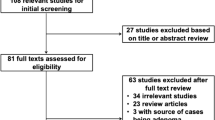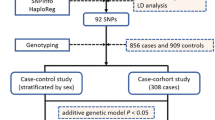Abstract
CYP19A1, or aromatase, influences estrogen-metabolizing enzymes and may influence cancer risk. We examine variation in the CYP19A1 gene and risk of colorectal cancer using data from population-based case–control studies (colon n = 1,574 cases, 1,970 controls; rectal n = 791 cases, 999 controls). Four SNPs were statistically significantly associated with colon cancer and four were associated with rectal cancer. After adjustment for multiple comparisons, the AA genotype of rs12591359 was associated with an increased risk of colon cancer (OR 1.44 95% CI 1.16–1.80) and the AA genotype of rs2470144 was associated with a reduced risk of rectal cancer (OR 0.65 95% CI 0.50–0.84). Variants of CYP19A1 were associated with CIMP+ and CIMP+/KRAS2-mutated tumors. CT/TT genotypes of rs1961177 were significantly associated with an increased likelihood of a MSI+ colon tumor (OR 1.77 95% CI 1.26–2.37). We observed statistically significant interactions between genetic variation in NFκB1 and CYP19A1 for both colon and rectal cancer. Our data suggest the importance of CYP19A1 in the development of colon and rectal cancer and that estrogen may influence risk through an inflammation-related mechanism.
Similar content being viewed by others
References
Nelson HD, Humphrey LL, Nygren P et al (2002) Postmenopausal hormone replacement therapy: scientific review. JAMA 288:872–881
Nanda K, Bastian LA, Hasselblad V, Simel DL (1999) Hormone replacement therapy and the risk of colorectal cancer: a meta-analysis. Obstet Gynecol 93:880–888
McMichael AJ, Potter JD (1980) Reproduction, endogenous and exogenous sex hormones, and colon cancer: a review and hypothesis. J Natl Cancer Inst 65:1201–1207
Chlebowski RT, Wactawski-Wende J, Ritenbaugh C et al (2004) Estrogen plus progestin and colorectal cancer in postmenopausal women. N Engl J Med 350:991–1004
Slattery ML, Ballard-Barbash R, Edwards S et al (2003) Body mass index and colon cancer: an evaluation of the modifying effects of estrogen (United States). Cancer Causes Control 14:75–84
Slattery ML, Potter JD, Curtin K et al (2001) Estrogens reduce and withdrawal of estrogens increase risk of microsatellite instability-positive colon cancer. Cancer Res 61:126–130
Slattery ML, Anderson K, Samowitz W et al (1999) Hormone replacement therapy and improved survival among postmenopausal women diagnosed with colon cancer (USA). Cancer Causes Control 10:467–473
Segev DL, Ha TU, Tran TT et al (2000) Mullerian inhibiting substance inhibits breast cancer cell growth through an NFkappa B-mediated pathway. J Biol Chem 275:28371–28379
Fagan DH, Yee D (2008) Crosstalk between IGF1R and estrogen receptor signaling in breast cancer. J Mammary Gland Biol Neoplasia 13:423–429
Catalano D, Trovato GM, Spadaro D et al (2008) Insulin resistance in postmenopausal women: concurrent effects of hormone replacement therapy and coffee. Climacteric 11:373–382
Marino M, Galluzzo P, Leone S et al (2006) Nitric oxide impairs the 17beta-estradiol-induced apoptosis in human colon adenocarcinoma cells. Endocr Relat Cancer 13:559–569
Slattery ML, Murtaugh MA, Quesenberry C et al (2007) Changing population characteristics, effect-measure modification, cancer risk factor identification. Epidemiol Perspect Innov 4:10
Cutolo M, Sulli A, Capellino S et al (2004) Sex hormones influence on the immune system: basic and clinical aspects in autoimmunity. Lupus 13:635–638
Deshpande R, Khalili H, Pergolizzi RG et al (1997) Estradiol down-regulates LPS-induced cytokine production and NFkB activation in murine macrophages. Am J Reprod Immunol 38:46–54
Camp NJ, Slattery ML (2002) Classification tree analysis: a statistical tool to investigate risk factor interactions with an example for colon cancer (United States). Cancer Causes Control 13:813–823
Marnett LJ (1992) Aspirin and the potential role of prostaglandins in colon cancer. Cancer Res 52:5575–5589
Slattery ML, Fitzpatrick FA (2009) Convergence of hormones, inflammation, and energy-related factors: a novel pathway of cancer etiology. Cancer Prev Res (Phila Pa) 2:922–930
Slattery ML, Sweeney C, Murtaugh M et al (2005) Associations between ERalpha, ERbeta, and AR genotypes and colon and rectal cancer. Cancer Epidemiol Biomarkers Prev 14:2936–2942
Lin J, Zee RY, Liu KY et al (2010) Genetic variation in sex-steroid receptors and synthesizing enzymes and colorectal cancer risk in women. Cancer Causes Control 21:897–908
Huber JC, Schneeberger C, Tempfer CB (2002) Genetic modelling of the estrogen metabolism as a risk factor of hormone-dependent disorders. Maturitas 42:1–12
Slattery ML, Potter JD, Duncan DM, Berry TD (1997) Dietary fats and colon cancer: assessment of risk associated with specific fatty acids. Int J Cancer 73:670–677
Slattery ML, Caan BJ, Benson J, Murtaugh M (2003) Energy balance and rectal cancer: an evaluation of energy intake, energy expenditure, and body mass index. Nutr Cancer 46:166–171
Slattery ML, Potter J, Caan B et al (1997) Energy balance and colon cancer-beyond physical activity. Cancer Res 57:75–80
Slattery ML, Edwards S, Curtin K et al (2003) Physical activity and colorectal cancer. Am J Epidemiol 158:214–224
Edwards S, Slattery ML, Mori M et al (1994) Objective system for interviewer performance evaluation for use in epidemiologic studies. Am J Epidemiol 140:1020–1028
Samowitz WS, Curtin K, Ma KN et al (2002) Prognostic significance of p53 mutations in colon cancer at the population level. Int J Cancer 99:597–602
Slattery ML, Curtin K, Anderson K et al (2000) Associations between cigarette smoking, lifestyle factors, and microsatellite instability in colon tumors. J Natl Cancer Inst 92:1831–1836
Samowitz WS, Curtin K, Schaffer D et al (2000) Relationship of Ki-ras mutations in colon cancers to tumor location, stage, and survival: a population-based study. Cancer Epidemiol Biomarkers Prev 9:1193–1197
Slattery ML, Curtin K, Sweeney C et al (2007) Diet and lifestyle factor associations with CpG island methylator phenotype and BRAF mutations in colon cancer. Int J Cancer 120:656–663
Conneely KN, Boehnke M (2007) So many correlated tests, so little time! Rapid adjustment of p values for multiple correlated tests. Am J Hum Genet 81:1158–1168
Slattery ML, Curtin K, Wolff RK et al (2009) A comparison of colon and rectal somatic DNA alterations. Dis Colon Rectum 52:1304–1311
Benjamini YaH Y (1995) Controlling the false discovery rate: a practical and powerful approach to multiple testing. J Roy Stat Soc 57:289–300
Kawakami K, Ruszkiewicz A, Bennett G et al (2006) DNA hypermethylation in the normal colonic mucosa of patients with colorectal cancer. Br J Cancer 94:593–598
Haiman CA, Dossus L, Setiawan VW et al (2007) Genetic variation at the CYP19A1 locus predicts circulating estrogen levels but not breast cancer risk in postmenopausal women. Cancer Res 67:1893–1897
Dick IM, Devine A, Prince RL (2005) Association of an aromatase TTTA repeat polymorphism with circulating estrogen, bone structure, and biochemistry in older women. Am J Physiol Endocrinol Metab 288:E989–E995
Dunning AM, Dowsett M, Healey CS et al (2004) Polymorphisms associated with circulating sex hormone levels in postmenopausal women. J Natl Cancer Inst 96:936–945
Salmen T, Heikkinen AM, Mahonen A et al (2003) Relation of aromatase gene polymorphism and hormone replacement therapy to serum estradiol levels, bone mineral density, and fracture risk in early postmenopausal women. Ann Med 35:282–288
Travis RC, Schumacher F, Hirschhorn JN et al (2009) CYP19A1 genetic variation in relation to prostate cancer risk and circulating sex hormone concentrations in men from the Breast and Prostate Cancer Cohort Consortium. Cancer Epidemiol Biomarkers Prev 18:2734–2744
Setiawan VW, Doherty JA, Shu XO et al (2009) Two estrogen-related variants in CYP19A1 and endometrial cancer risk: a pooled analysis in the Epidemiology of Endometrial Cancer Consortium. Cancer Epidemiol Biomarkers Prev 18:242–247
Cai Q, Kataoka N, Li C et al (2008) Haplotype analyses of CYP19A1 gene variants and breast cancer risk: results from the Shanghai Breast Cancer Study. Cancer Epidemiol Biomarkers Prev 17:27–32
Tao MH, Cai Q, Zhang ZF et al (2007) Polymorphisms in the CYP19A1 (aromatase) gene and endometrial cancer risk in Chinese women. Cancer Epidemiol Biomarkers Prev 16:943–949
Wang L, Ellsworth KA, Moon I et al (2010) Functional genetic polymorphisms in the aromatase gene CYP19 vary the response of breast cancer patients to neoadjuvant therapy with aromatase inhibitors. Cancer Res 70:319–328
Xu WH, Dai Q, Xiang YB et al (2007) Interaction of soy food and tea consumption with CYP19A1 genetic polymorphisms in the development of endometrial cancer. Am J Epidemiol 166:1420–1430
Guo Y, Xiong DH, Yang TL et al (2006) Polymorphisms of estrogen-biosynthesis genes CYP17 and CYP19 may influence age at menarche: a genetic association study in Caucasian females. Hum Mol Genet 15:2401–2408
Riggins RB, Bouton AH, Liu MC, Clarke R (2005) Antiestrogens, aromatase inhibitors, and apoptosis in breast cancer. Vitam Horm 71:201–237
Sato R, Suzuki T, Katayose Y et al (2009) Steroid sulfatase and estrogen sulfotransferase in colon carcinoma: regulators of intratumoral estrogen concentrations and potent prognostic factors. Cancer Res 69:914–922
Acknowledgments
This study was funded by NCI Grants CA48998 and CA61757. This research also was supported by the Utah Cancer Registry, which is funded by Contract #N01-PC-67000 from the National Cancer Institute, with additional support from the State of Utah Department of Health, the Northern California Cancer Registry, and the Sacramento Tumor Registry. The contents of this manuscript are solely the responsibility of the authors and do not necessarily represent the official view of the National Cancer Institute. We would like to acknowledge the contributions of Sandra Edwards, Roger Edwards, Leslie Palmer, Donna Schaffer, Dr. Kristin Anderson, and Judy Morse for data management and collection.
Conflict of interest
No authors have any conflict of interest to report.
Author information
Authors and Affiliations
Corresponding author
Electronic supplementary material
Below is the link to the electronic supplementary material.
Rights and permissions
About this article
Cite this article
Slattery, M.L., Lundgreen, A., Herrick, J.S. et al. Variation in the CYP19A1 gene and risk of colon and rectal cancer. Cancer Causes Control 22, 955–963 (2011). https://doi.org/10.1007/s10552-011-9768-x
Received:
Accepted:
Published:
Issue Date:
DOI: https://doi.org/10.1007/s10552-011-9768-x




